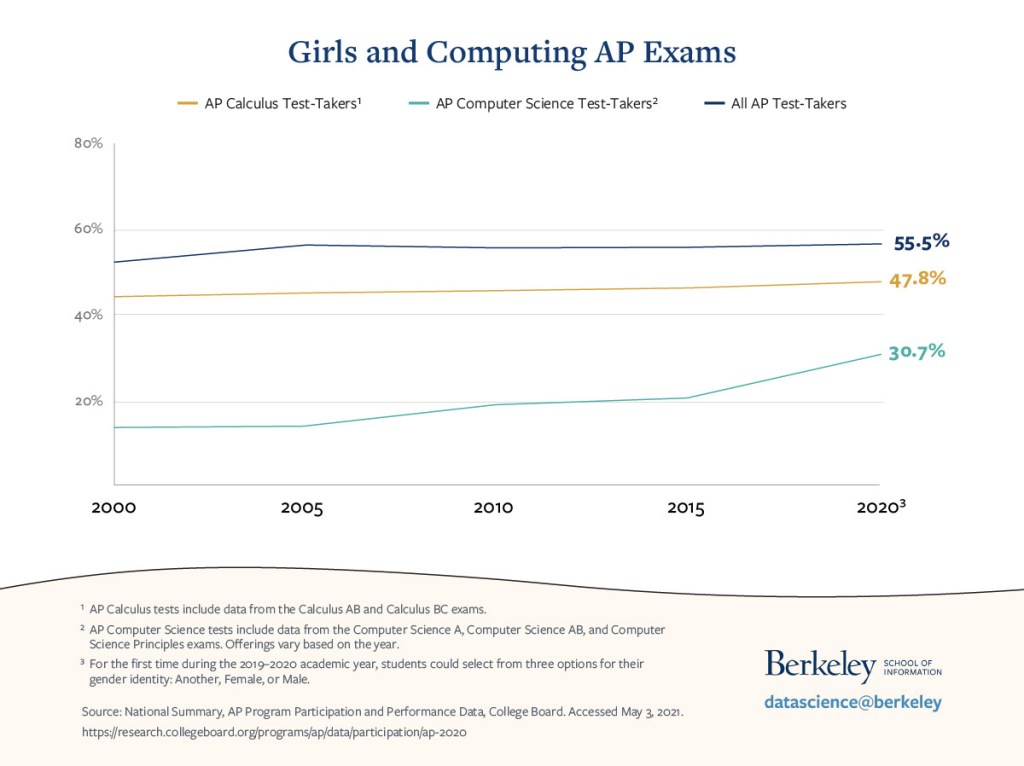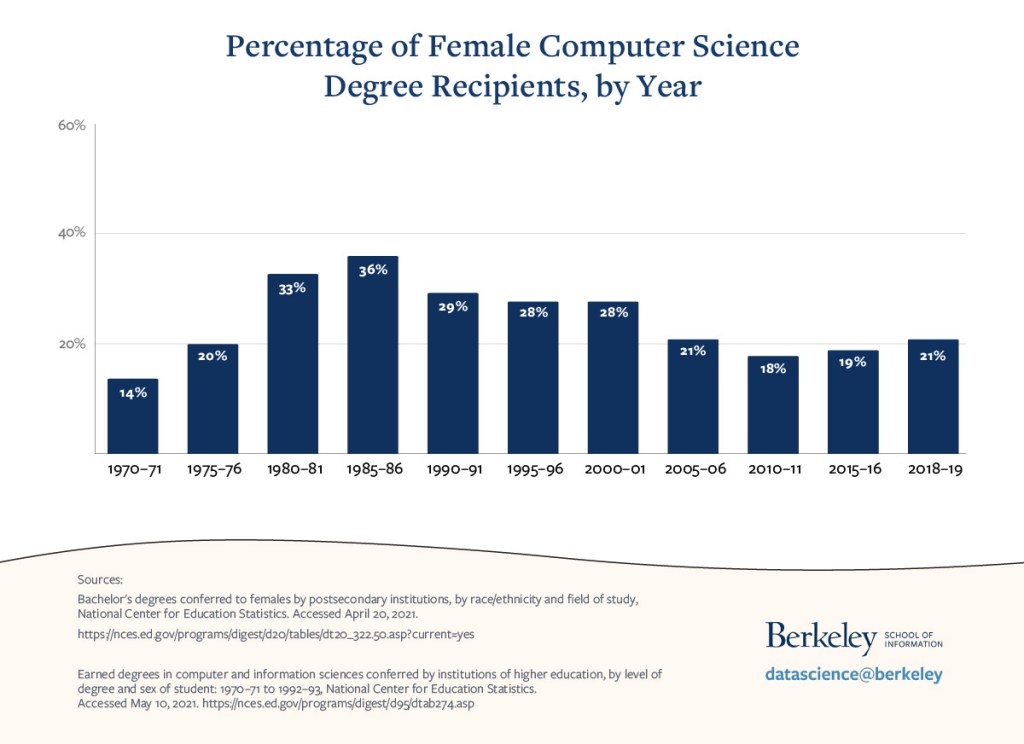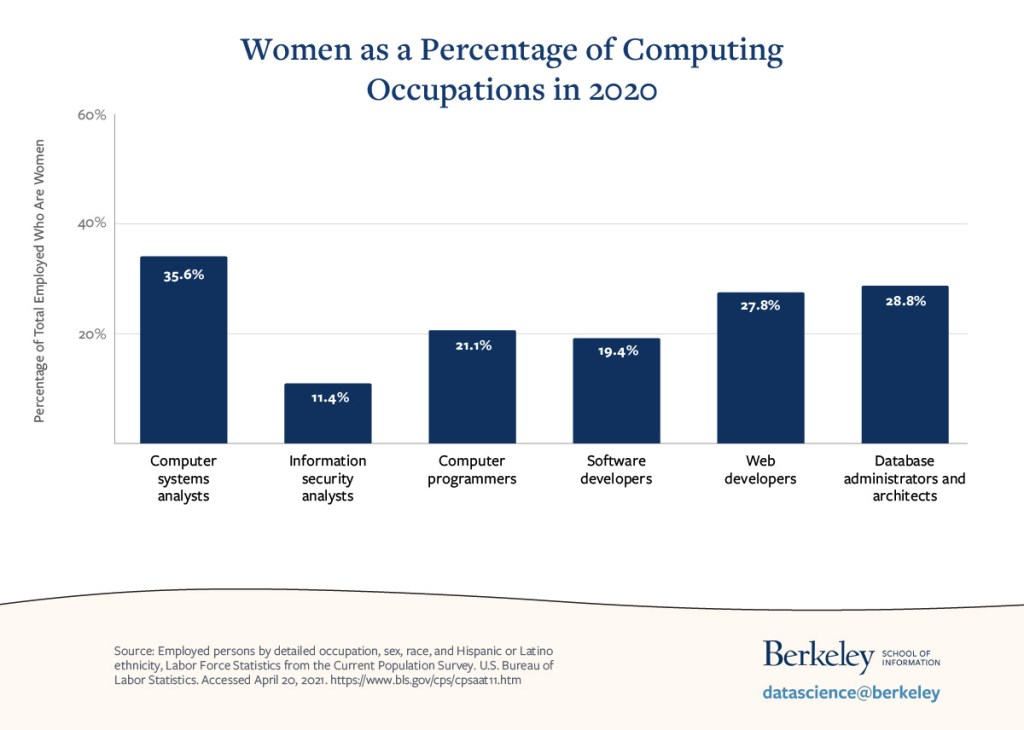Changing the Curve: Women in Computing

More than 150 years ago, Ada Lovelace wrote the first computer program—an algorithm to calculate Bernoulli sequences. Since then, women have continued to be at the forefront of some major industry-changing advancements in computer science.
From developing the first compiler to uncovering bias in AI recognition software, women’s contributions to computing are varied and important — but not always credited or celebrated.
According to The New York Times, women were the predominant software engineers of the 1940s: “At the time, men in the computing industry regarded writing code as a secondary, less interesting task.”
But as the industry became more desirable for men, women became a shrinking minority. Women comprised 37 percent of all students graduating with degrees in computer and information sciences in 1984. By 2010, they accounted for less than half that.
datascience@berkeley explores the history and influence of women in computing and reviews the state of the gap between women and men in computing today.
Timeline of Women’s Achievements in Computing and Computer Science
1843
ADA LOVELACE expands on Charles Babbage’s Analytical Engine. She is widely considered the first computer programmer.
1946
ENIAC PROGRAMMERS program the first all-electronic, programmable computer for the U.S. army. The six women were not credited for their work.
1952
GRACE HOPPER invents the first computer compiler.
1962
KATHERINE JOHNSON performs the orbital calculations needed for John Glenn’s orbital space mission.
1965
SISTER MARY KENNETH KELLER is the first woman to earn a Ph.D. in computer science in the United States.
1978
CAROL SHAW becomes the first professional female video game designer.
1985
RADIA PERLMAN invents the Spanning Tree Protocol. She is referred to as the “Mother of the Internet.”
1997
ANITA BORG founds the Institute for Women in Technology.
2005
RUCHI SANGHVI is hired as the first female engineer at Facebook.
2018
JOY BUOLAMWINI authors research uncovering large racial and gender bias in AI services. She is the founder of the Algorithmic Justice League.
Women and Computing Education
The computing field, and women’s involvement in it, predates traditional computer science education. The first department began at Purdue University in the 1960s, almost 100 years after Ada Lovelace wrote the first computer program.
Today, degree programs are prolific. But the data about the students involved with them reveals large gender gaps at all levels of schooling.
For example, the Advanced Placement (AP) Exam — a standardized test for high-achieving high school students in the subject of their choosing — has been administered to more female than male students since the year 2000.
However, girls make up slightly less than half of all calculus test-takers in the program. An even wider gap exists among computer science students: Despite the doubling of the proportion of test-takers who are female in the past 20 years, College Board data indicates they are still less than one-third.

In 2000, females were about 54 percent of all Advanced Placement exam test-takers. That same year, they were 45 percent of AP Calculus test-takers and 15 percent of AP Computer Science test-takers. Since then, the percentage of all test-takers who are female has risen to almost 56 percent. In 2020, females were 47 percent of AP Calculus test-takers and 31 percent of AP Computer Science test-takers.
As students rise through the education system, gender gaps in computing persist.
Women make up more of the overall population of bachelor’s degree recipients—57 percent in 2019, according to the National Center for Education Statistics. However, as with AP exams, women are disproportionately underrepresented in the computing field.
The same data reveals that in 1986, women comprised about 36 percent of computer and information science bachelor’s degree recipients, but that number fell to less than half by 2010. Most recent data shows that women receive about one in five of conferred computing bachelor’s degrees.

In 1971, only 14 percent of computer science bachelor’s degree recipients were women. The proportion of women receiving these degrees peaked during the mid-1980s — in 1986, 36 percent of all recipients were women. Since then, the number has declined. As of 2019, 21 percent of computer science bachelor’s degree recipients were women.
Women and the Computing Workforce
The decline of girls entering computer science programs trickled down to the workforce quickly. In 1991, women held about 36 percent of computing occupations, according to the National Center for Women and Information Technology.
By 2014, they were only about one-fourth of computing professionals. Overall, the proportion of women in computer and mathematical occupations has declined 19 percent since 1995, according to data from the U.S. Bureau of Labor Statistics.
Today, women’s participation in computing occupations varies by position.

In 2020, women comprised 36 percent of computer systems analysts, 12 percent of information security analysts, 21 percent of computer programmers, 19 percent of software developers, 28 percent of web developers and 29 percent of database administrators and architects.
The employment gender gap is larger for women of color. In 2020, the computing workforce was 3 percent Black women, 2 percent Hispanic women and 7 percent Asian women, according to WIT by the Numbers 2021.
Why are girls and women not pursuing computing as often as their male counterparts?
Research does not have a conclusive answer, but survey data points to some of the differences in how men and women value their careers.
For example, women were significantly more likely than men to cite, “I am interested in helping people or society” as a reason for pursuing a computing degree, according to a Girls in IT report from Microsoft.
But even this preference cannot stand on its own. The Microsoft report states that “girls do not come by these perceptions, interests, and career decisions innately or in a vacuum. Indeed, these are shaped by the larger society and local environments in which they learn about computing and technology.”
The report shows that abstract curriculum fails to connect the social influence of computing to the profession; a tendency toward independent, non-collaborative learning; and unconscious biases about “innate” talent all contribute to an industry that systematically favors boys’ development and learning.
Women and Computing Leadership
At the highest levels of professional leadership in computing and technology, women are making strides: Twenty percent of newly funded startups in 2019 have a female founder, double the amount in 2009, according to a Crunchbase report.
This is good for business because women-led startups tend to be more financially efficient. WeROC, a women-focused entrepreneurship program, found that women-led startups deliver twice as much per dollar invested than those founded by men.
In the C-suite, women are slowly getting more seats at the table. Korn Ferry analysis of largest U.S. companies reveals that women make up 18 percent of CIO/CTO positions among the top 1,000 U.S. companies (based on revenue), up from 16 percent the prior year. However, among C-suites in the tech industry, women are just 10 percent of CIO/CTO positions.
Additional Resources
Below are some curated resources, toolkits, and organizations dedicated to helping women pursue and navigate computing careers in a male-centered workforce.
For Women
For Women of Color
Citation for this content: datascience@berkeley, the online Master of Information and Data Science from the UC Berkeley School of Information.

